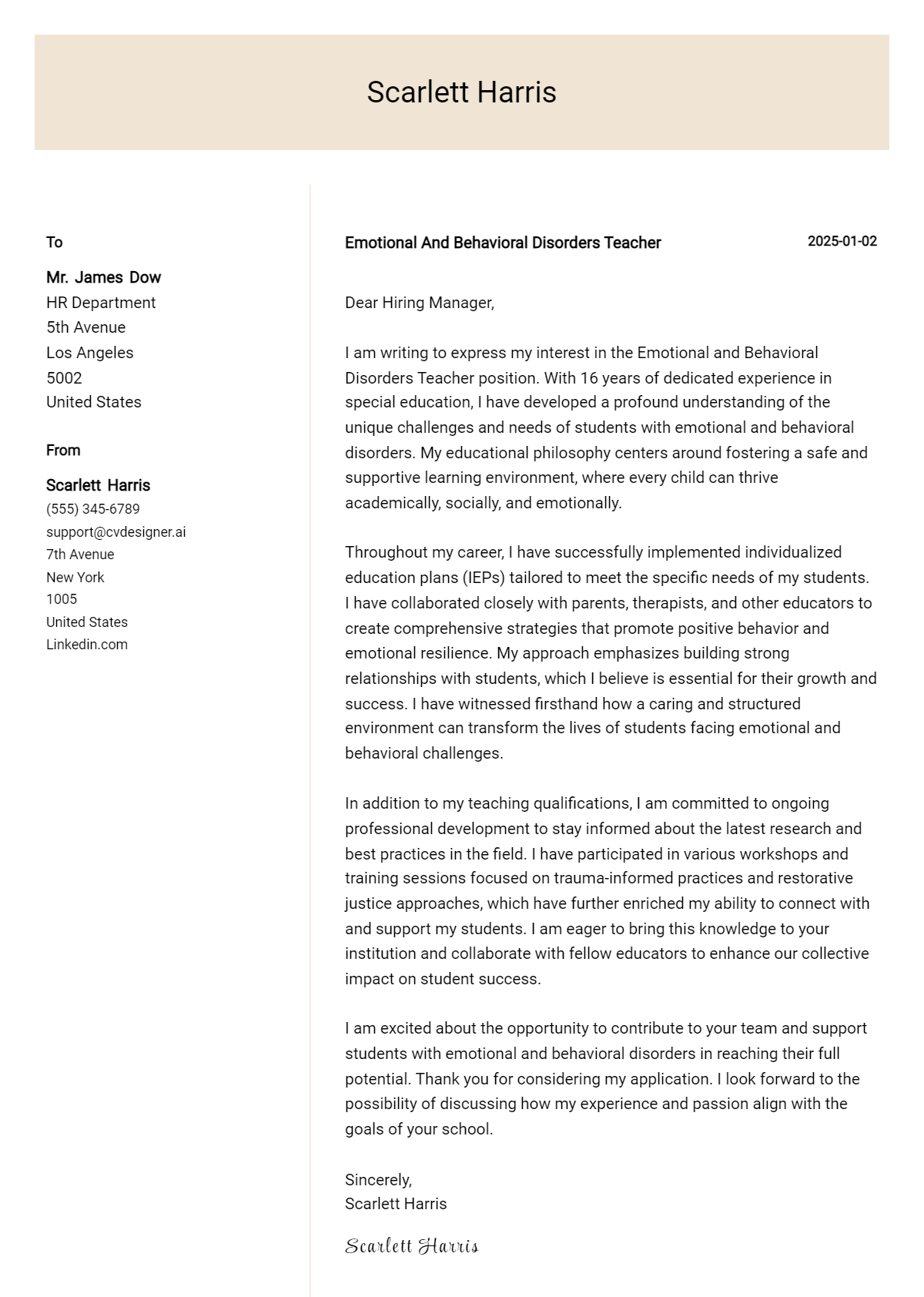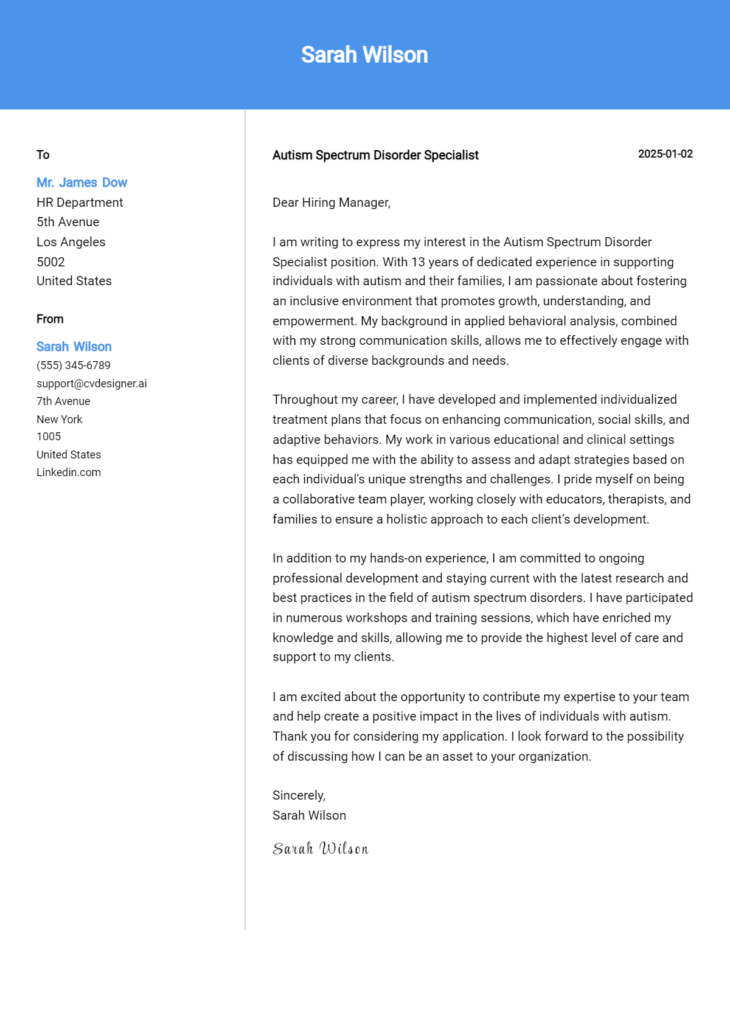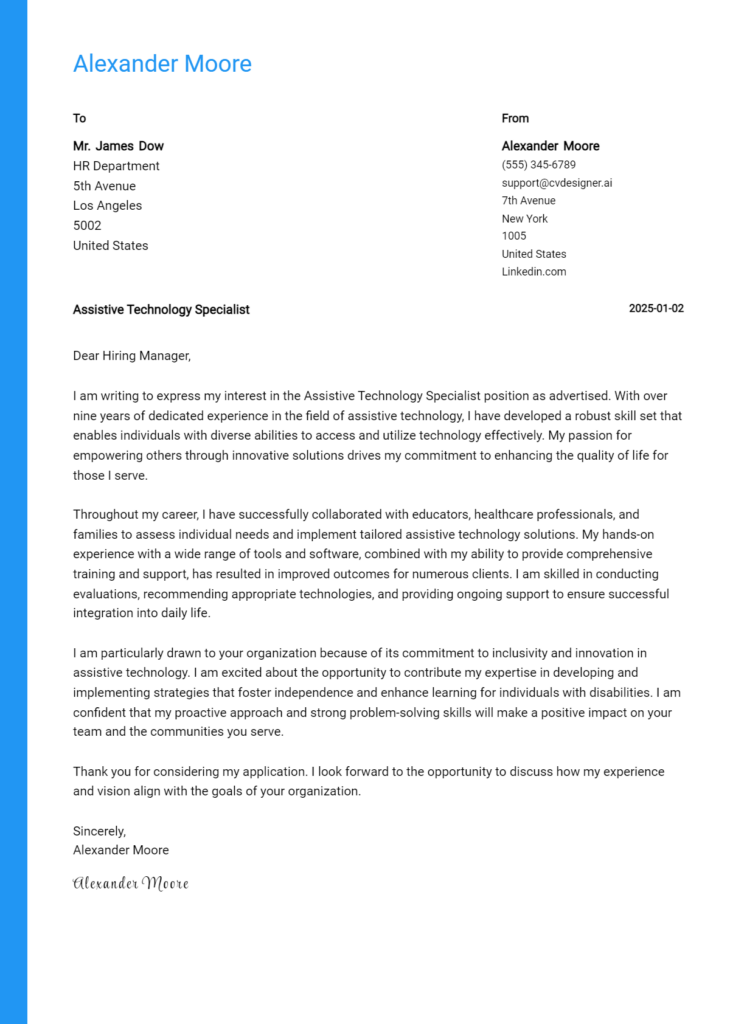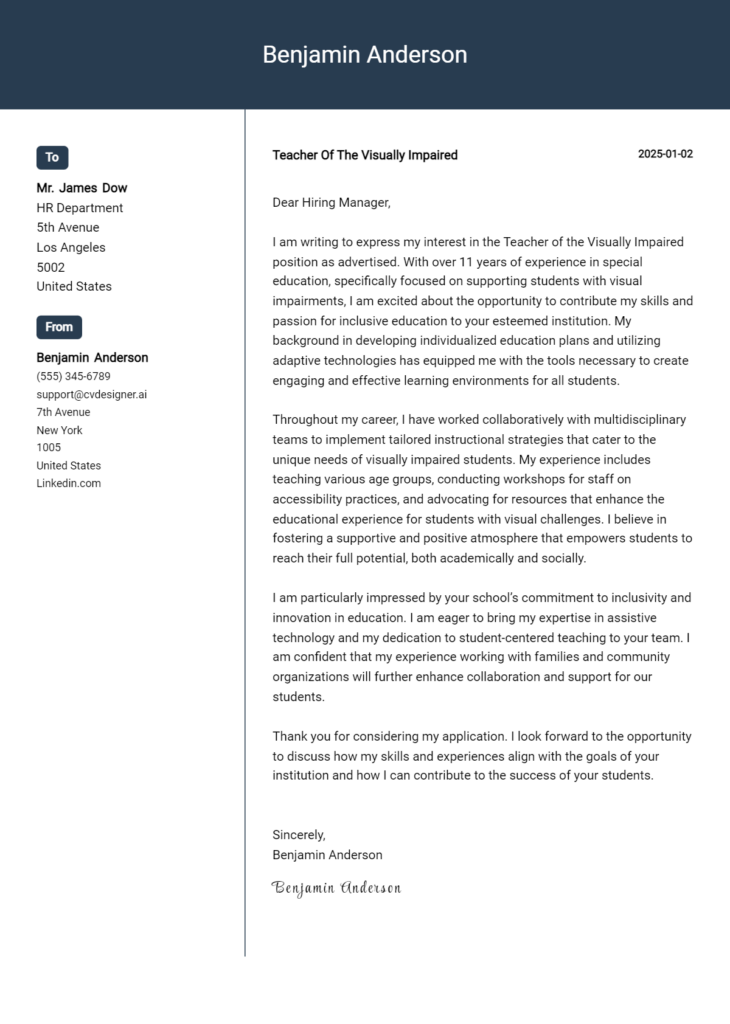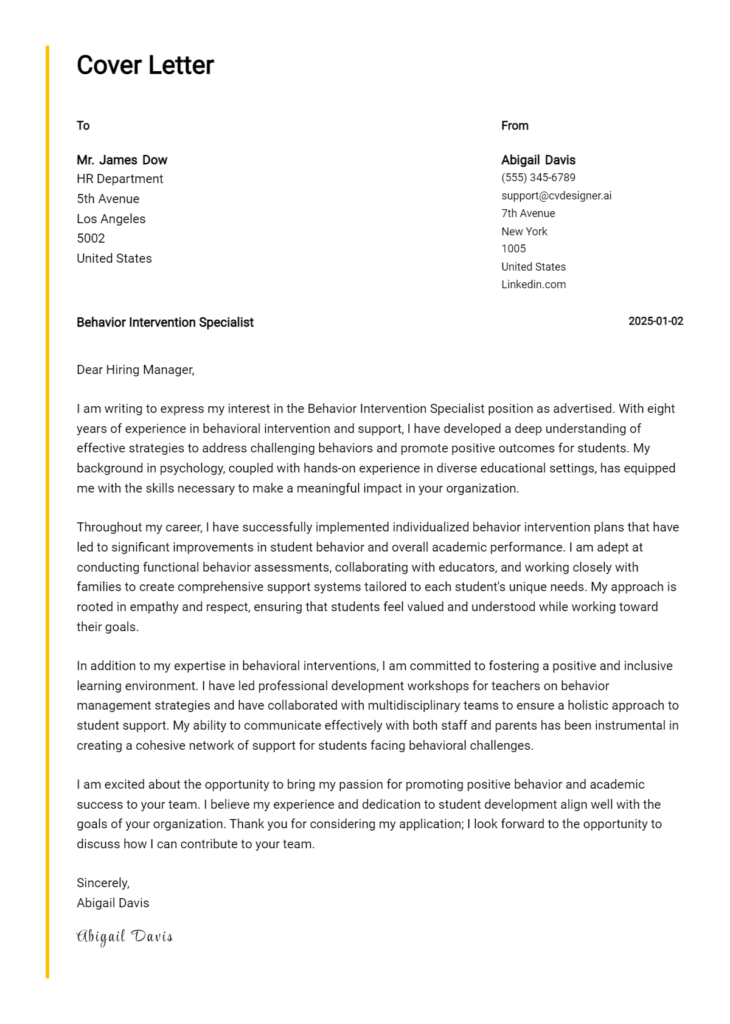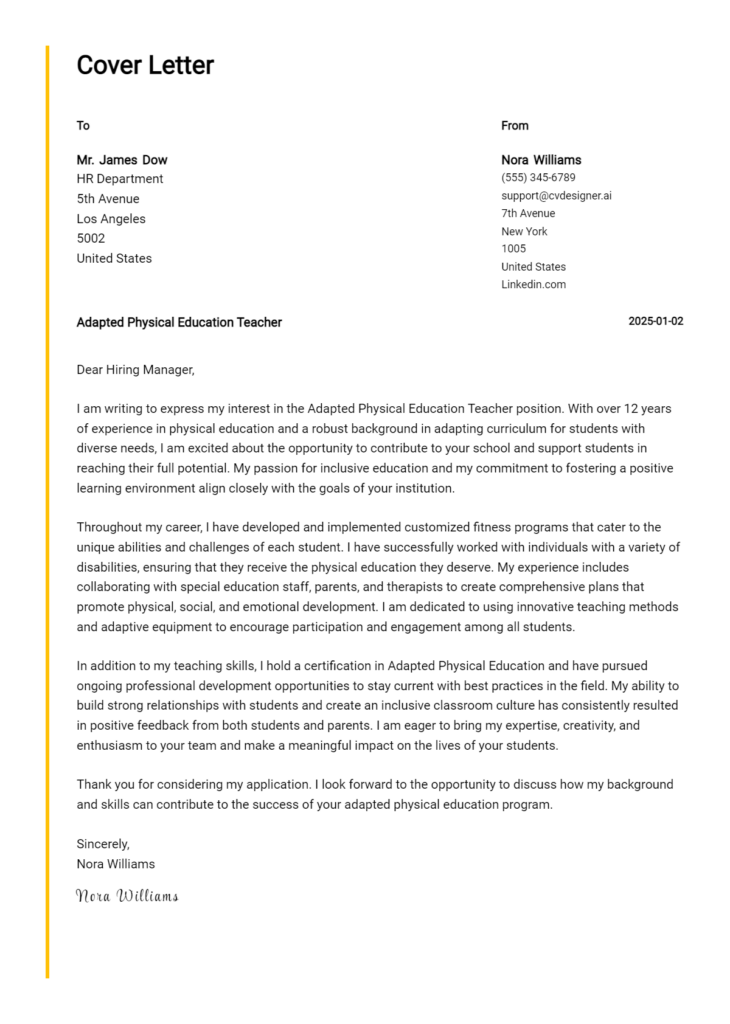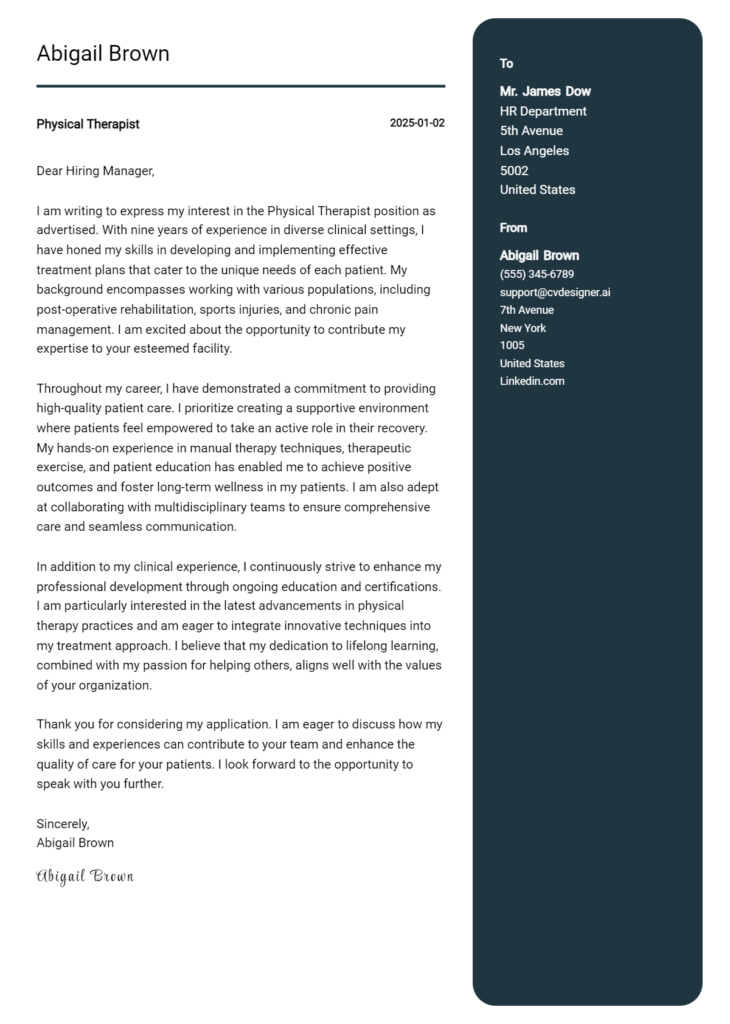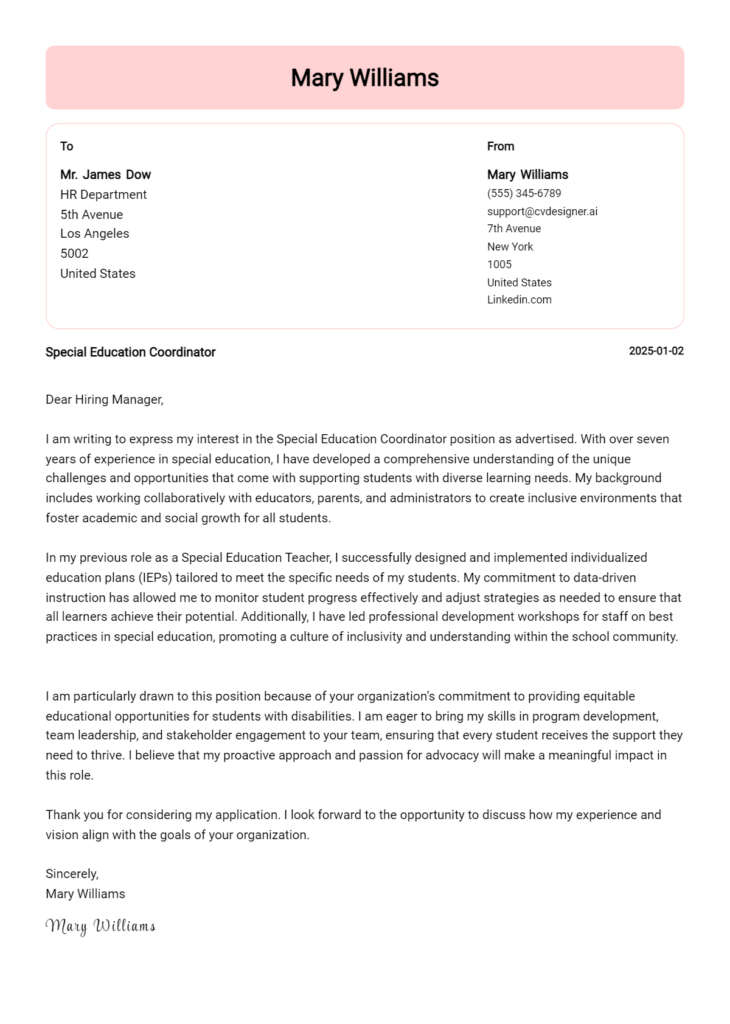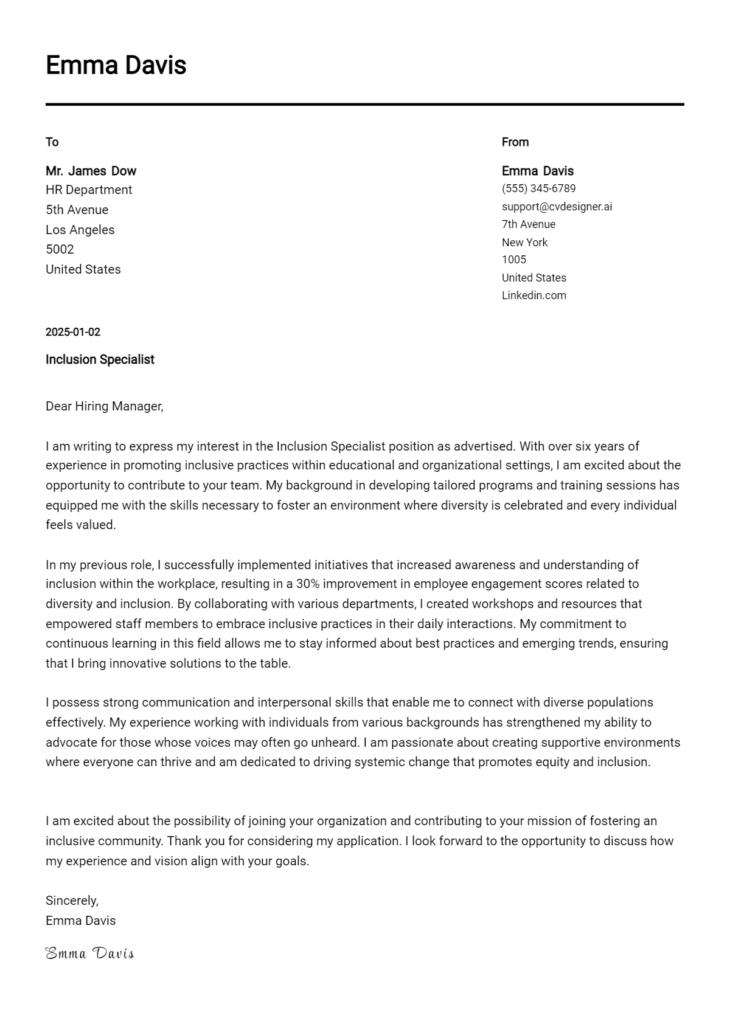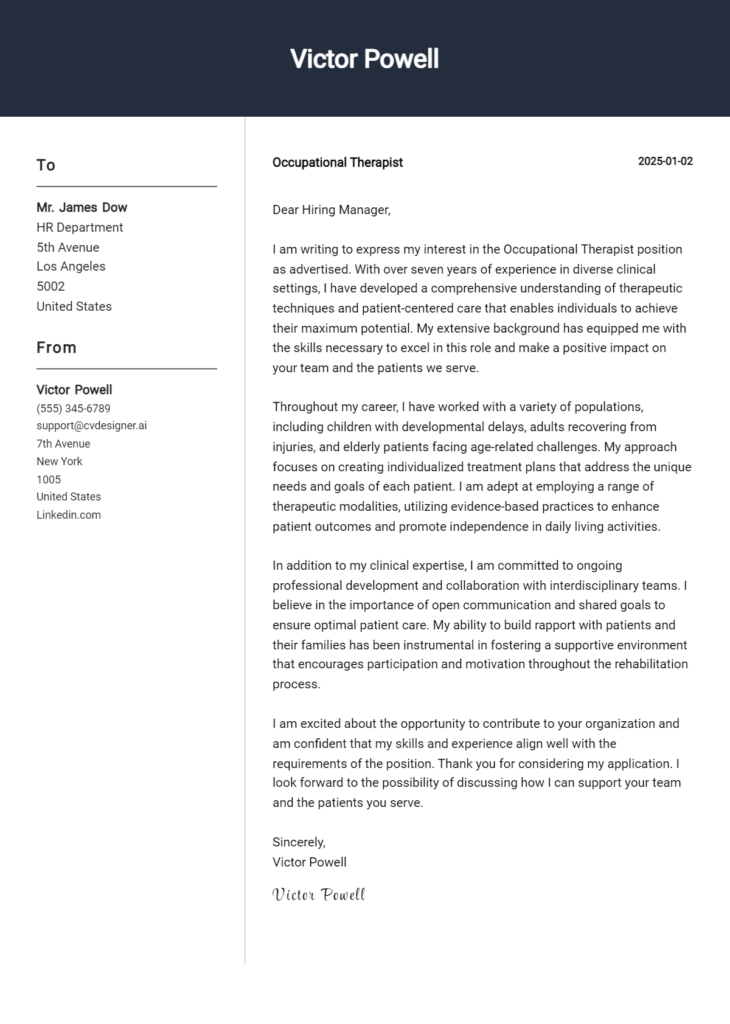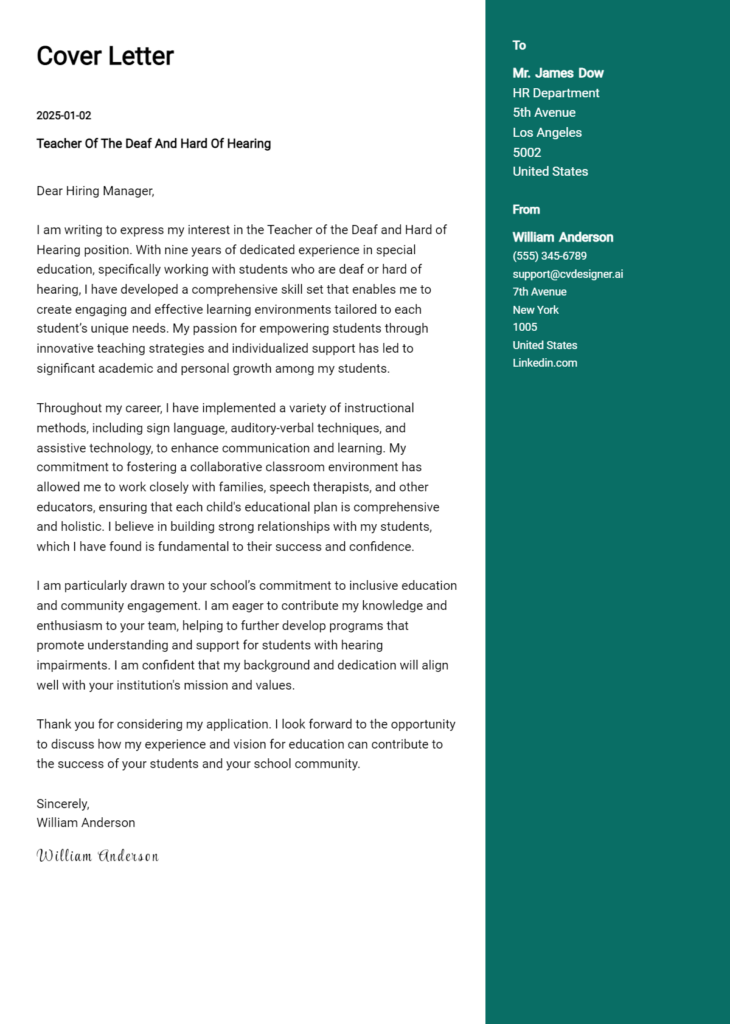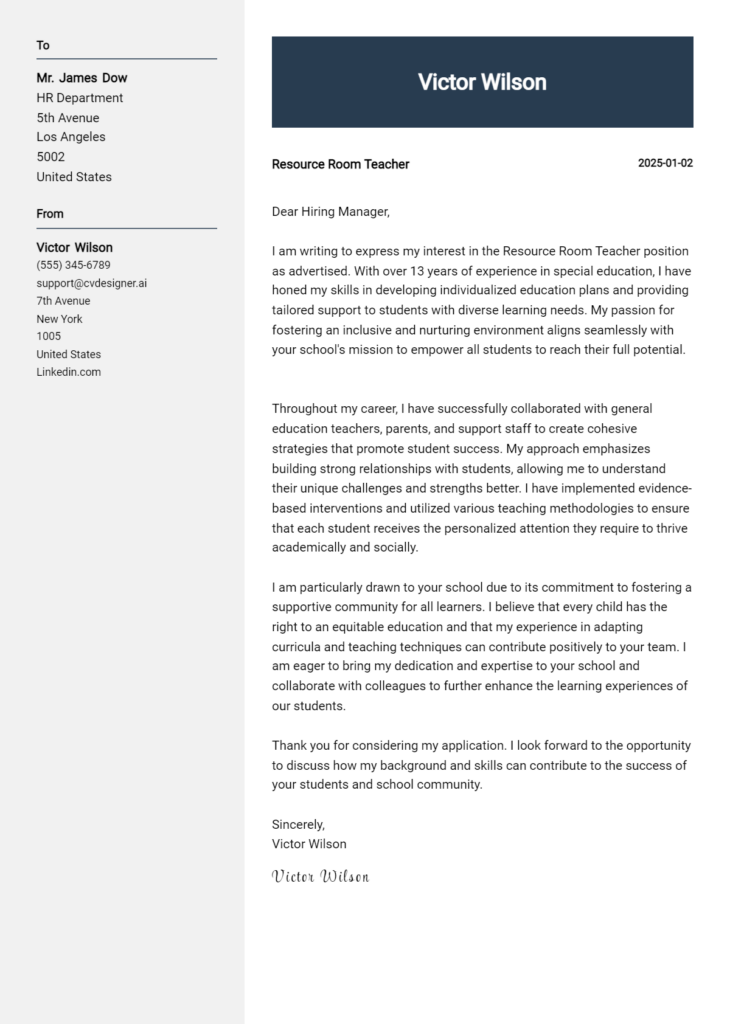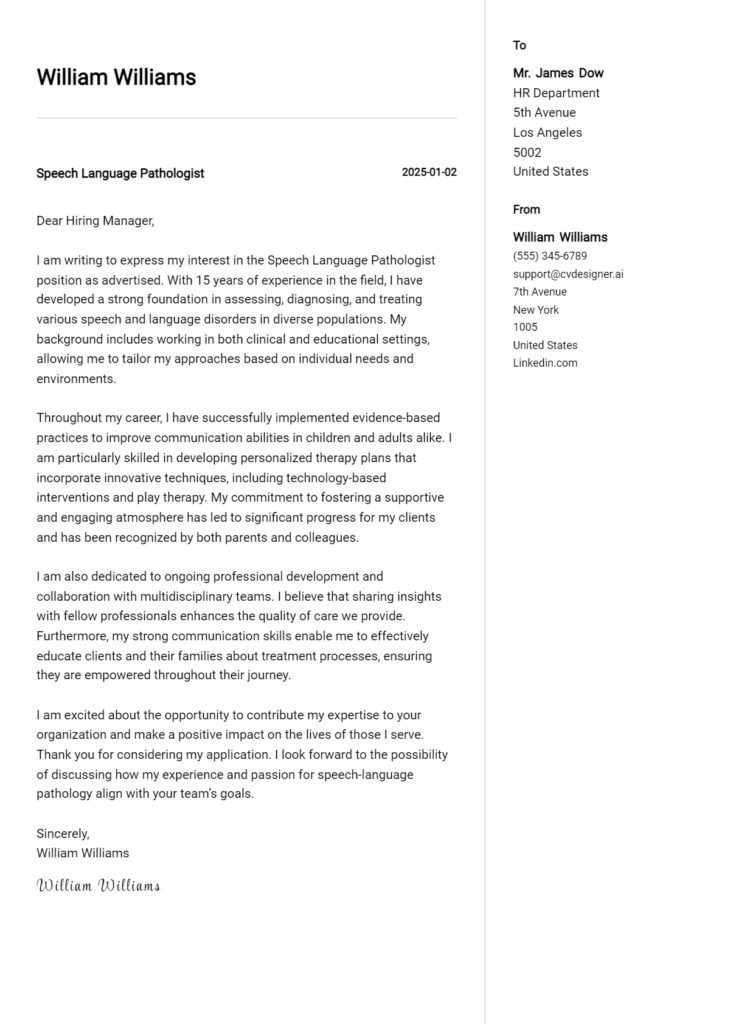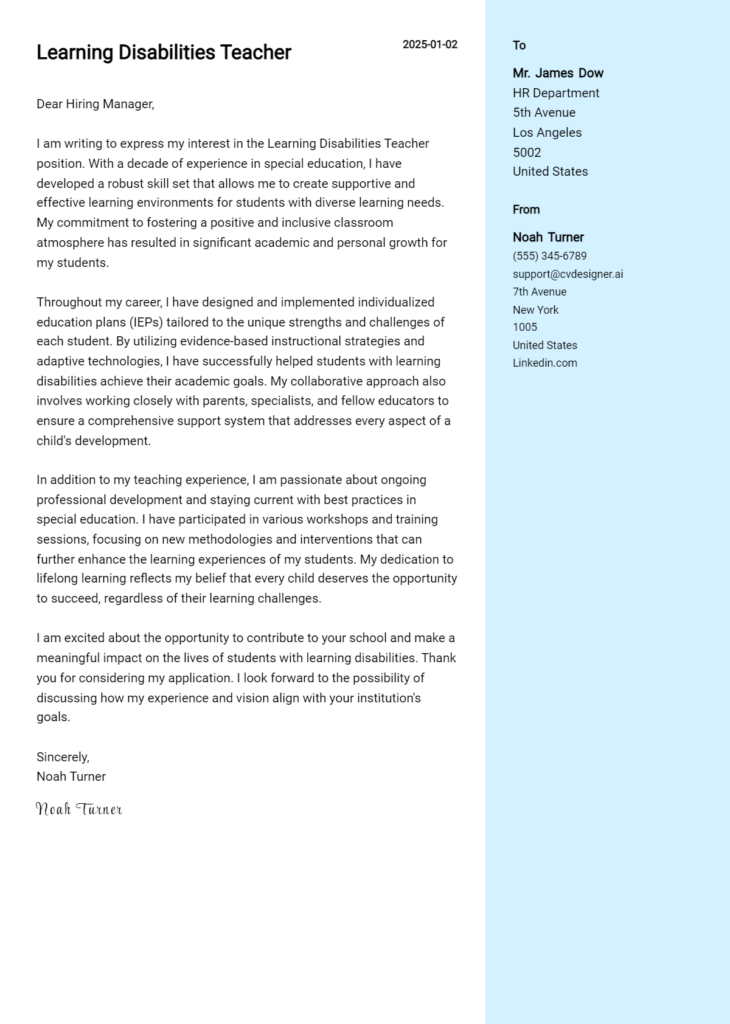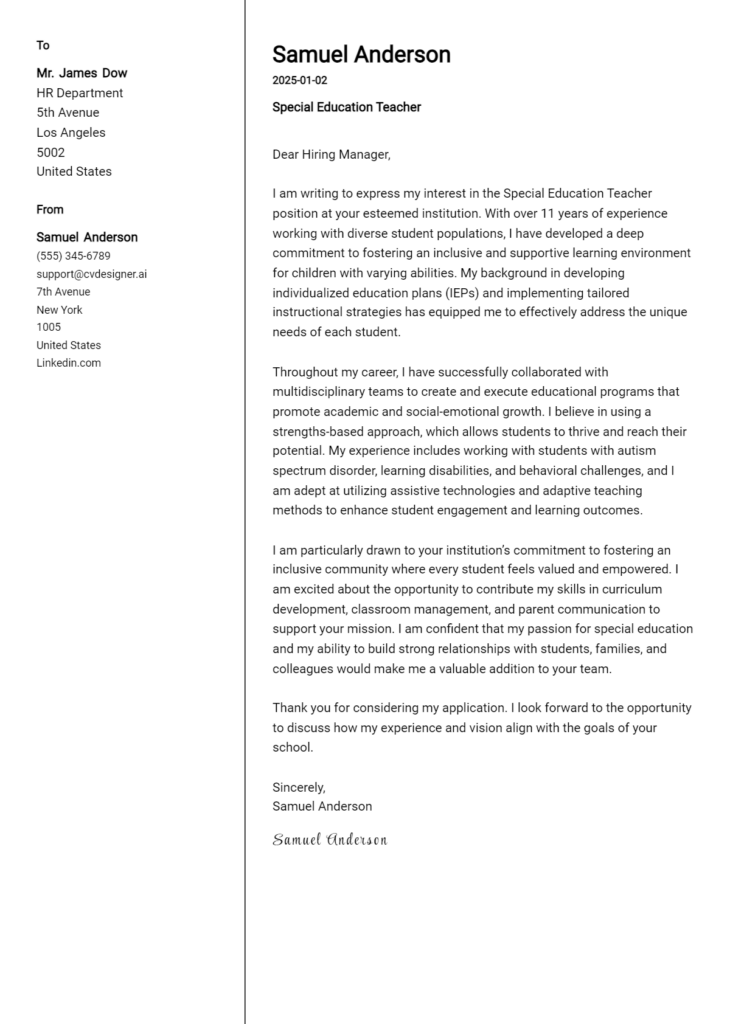Emotional And Behavioral Disorders Teacher Cover Letter Examples
Explore additional Emotional And Behavioral Disorders Teacher cover letter samples and guides and see what works for your level of experience or role.
How to Format a Emotional and Behavioral Disorders Teacher Cover Letter?
Crafting a compelling cover letter for an Emotional and Behavioral Disorders Teacher position is essential, as it not only conveys your qualifications but also demonstrates your ability to connect with students who may face unique challenges. The format of your cover letter serves as a reflection of your teaching philosophy, highlighting your commitment to fostering a supportive and inclusive environment. A well-structured cover letter can effectively capture the hiring manager's attention and showcase your understanding of the complexities involved in teaching students with emotional and behavioral disorders.
In this guide, we'll outline how to structure your cover letter, providing insights and role-specific examples to help you create a persuasive document.
We'll focus on the essential components of a professional cover letter, including:
- Cover Letter Header
- Cover Letter Greeting
- Cover Letter Introduction
- Cover Letter Body
- Cover Letter Closing
Each section is crucial in demonstrating your professionalism and dedication to the role. Let’s break down each part and explain how to make your Emotional and Behavioral Disorders Teacher cover letter shine.
Importance of the Cover Letter Header for an Emotional and Behavioral Disorders Teacher
The header of a cover letter is crucial as it sets the tone for the entire document and provides essential information at a glance. For an Emotional and Behavioral Disorders Teacher, clarity and professionalism in the header are particularly important, as they reflect your attention to detail and your commitment to effective communication—key skills when working with students who may face emotional and behavioral challenges. The header should include your contact information, the date, and the recipient's details, ensuring that it is easy to read and well-organized.
A strong header immediately conveys your professionalism, while a weak header can leave a negative impression before the reader even delves into the content of your letter.
Strong Example:
Jane Doe 123 Main Street Anytown, ST 12345 jane.doe@email.com (555) 123-4567 October 1, 2023 Mr. John Smith Hiring Manager Anytown School District 456 Education Lane Anytown, ST 12345
Weak Example:
jane doe 123 main st anytown, st 10/1/23 To whom it may concern
The Importance of a Strong Cover Letter Greeting
The greeting of your cover letter serves as the first impression you make on a potential employer, setting the tone for the rest of your application. For an Emotional and Behavioral Disorders Teacher, this initial interaction is particularly crucial; it showcases your professionalism and commitment to personalizing your approach. By addressing the hiring manager directly, you convey respect and diligence, indicating that you have taken the time to research the organization and its staff. Avoiding generic greetings like "To Whom It May Concern" not only demonstrates your attention to detail but also helps you establish a connection with the reader. When possible, take the extra step to find the recipient's name through the school's website or LinkedIn.
Strong Greeting Example
Dear Ms. Johnson,
Weak Greeting Example
To Whom It May Concern,
The Importance of a Well-Crafted Cover Letter Introduction for an Emotional and Behavioral Disorders Teacher
A well-crafted cover letter introduction is crucial for an Emotional and Behavioral Disorders Teacher as it sets the tone for the entire application. This opening paragraph should capture the hiring manager's attention, express genuine interest in the role, and briefly showcase relevant skills or achievements that position the candidate as a strong fit for the job. A compelling introduction not only creates a positive first impression but also encourages the reader to engage with the rest of the application. Below are examples of strong and weak cover letter introductions to illustrate the difference.
Strong Example
Dear [Hiring Manager's Name], I am excited to apply for the Emotional and Behavioral Disorders Teacher position at [School Name], where I can leverage my eight years of experience in special education to create a supportive and engaging learning environment for students with diverse emotional and behavioral needs. My commitment to fostering resilience and academic success is evidenced by my recent implementation of a targeted social-emotional learning program that improved student engagement by 30%. I am eager to bring my passion and proven strategies to your team and help empower students to thrive both academically and personally.
Weak Example
To Whom It May Concern, I am writing to apply for the Emotional and Behavioral Disorders Teacher position. I have worked in education for a few years and think it would be a good job for me. I have some experience with students who have emotional issues, but I am not sure how much I can help them. I hope to hear back soon.
Purpose of the Cover Letter Body for an Emotional and Behavioral Disorders Teacher
The body of a cover letter for an Emotional and Behavioral Disorders Teacher serves as a critical platform for candidates to articulate their unique qualifications, relevant experiences, and the valuable contributions they can bring to the educational institution. This section allows candidates to highlight specific projects or accomplishments that demonstrate their expertise in managing diverse learning needs and fostering a positive, inclusive classroom environment. By articulating their skills in behavior management, individualized instruction, and collaboration with interdisciplinary teams, candidates can effectively showcase their commitment to supporting students with emotional and behavioral challenges.
Strong Example
Dear [Hiring Manager's Name], I am excited to apply for the Emotional and Behavioral Disorders Teacher position at [School Name]. In my previous role at [Previous School], I successfully developed and implemented a social skills curriculum that resulted in a 30% improvement in students’ social interactions over the academic year. By utilizing positive reinforcement techniques and individualized behavior intervention plans, I was able to create a supportive learning environment that encouraged personal growth and academic success. Furthermore, my collaboration with mental health professionals to integrate therapeutic practices into daily lessons has equipped me with the skills necessary to address the unique challenges faced by students with emotional and behavioral disorders. I am eager to bring my passion and experience to [School Name] and contribute to the success of your students. Sincerely, [Your Name]
Weak Example
Dear [Hiring Manager's Name], I am writing to apply for the Emotional and Behavioral Disorders Teacher position. I have worked with children for a long time and I think I would be a good fit for your school. I like helping students, and I believe I can make a difference. I have done some things in my previous job, but I can't remember all the details. I believe every child deserves a chance to succeed. I hope to work at [School Name] and help students with their problems. Best, [Your Name]
Cover Letter Closing for Emotional and Behavioral Disorders Teacher
The closing paragraph of a cover letter for an Emotional and Behavioral Disorders Teacher is crucial as it leaves a lasting impression on the hiring committee. This section should effectively summarize your qualifications, reaffirm your enthusiasm for the position, and encourage the reader to take the next steps, such as reviewing your resume or scheduling an interview. A strong closing can reinforce your fit for the role, while a weak one may leave the reader uncertain about your candidacy.
Strong Example
Thank you for considering my application for the Emotional and Behavioral Disorders Teacher position. With my background in special education and over five years of experience working with students with emotional and behavioral challenges, I am excited about the opportunity to contribute to your team. I am eager to bring my skills in individualized instruction and behavioral management to your school. I look forward to discussing how I can support your students’ success and would be thrilled to provide further details during an interview. Please find my resume attached for your review.
Weak Example
I hope you consider my application. I think I would be a good fit for the Emotional and Behavioral Disorders Teacher role. I have some experience, and my resume is attached. If you want to talk, you can call me or email me.
These tips will guide candidates in crafting an effective cover letter for the role of an Emotional and Behavioral Disorders Teacher. A well-written cover letter not only showcases your technical skills and problem-solving abilities but also highlights your knowledge of the Social Developmental Learning Curriculum (SDLC), your ability to work collaboratively in a team, and your passion for continuous learning. By emphasizing these qualities, you can demonstrate your suitability for the position and your commitment to fostering a supportive environment for students with emotional and behavioral challenges.
Tips for Writing an Effective Cover Letter
Highlight Relevant Technical Skills
Clearly outline your technical skills related to emotional and behavioral disorders. Mention your proficiency in behavioral assessment tools, individualized education plans (IEPs), and classroom management techniques. Providing specific examples of how you've utilized these skills in previous roles can strengthen your application significantly.Showcase Problem-Solving Abilities
Emotional and behavioral challenges often require creative problem-solving strategies. In your cover letter, include instances where you successfully addressed a difficult situation in the classroom. Describe the steps you took and the outcomes, illustrating your ability to think critically under pressure.Demonstrate Knowledge of SDLC
Familiarize yourself with the Social Developmental Learning Curriculum, as it plays a crucial role in guiding effective teaching strategies for students with emotional and behavioral disorders. Mention any relevant training or experience you have with SDLC and how you've applied this knowledge to enhance student learning and emotional well-being.Emphasize Teamwork and Collaboration
Teaching students with emotional and behavioral disorders often involves collaboration with other educators, counselors, and parents. Highlight your experience working in teams and how your collaborative approach has benefited students. Provide examples of successful partnerships that led to positive outcomes.Express a Passion for Continuous Learning
The field of education is ever-evolving, particularly in the area of emotional and behavioral disorders. Convey your commitment to professional development by mentioning relevant workshops, courses, or certifications you have pursued. This not only shows your dedication to improving your skills but also indicates your desire to provide the best support for your students.
By following these tips and utilizing resources like cover letter templates and a cover letter builder, you can craft a compelling cover letter that effectively communicates your qualifications and passion for the role.
Common Mistakes to Avoid in an Emotional and Behavioral Disorders Teacher Cover Letter
Crafting an effective cover letter is essential for standing out in the competitive field of education, especially for roles like an Emotional and Behavioral Disorders Teacher. Avoiding common mistakes can significantly enhance your chances of securing an interview. Here are some pitfalls to look out for:
Generic Content: Many applicants use a one-size-fits-all approach. Tailor your letter to the specific school and position by highlighting your relevant experiences and skills. Research the institution and mention how you align with their values.
Neglecting Formatting: A cluttered or unprofessional layout can detract from your message. Ensure your cover letter follows a clear cover letter format and is easy to read, with appropriate margins and spacing.
Focusing on Responsibilities Instead of Achievements: Instead of listing job duties, emphasize your accomplishments and how they positively impacted students. Use specific examples to demonstrate your effectiveness in managing emotional and behavioral challenges.
Lack of Personalization: Failing to address the hiring manager by name can make your letter feel impersonal. Whenever possible, find out the name of the person you should address and use it in your greeting.
Overusing Educational Jargon: While it's important to showcase your expertise, overloading your cover letter with technical terms can alienate readers. Use clear, accessible language to convey your passion for teaching and your understanding of behavioral disorders.
Ignoring the Call to Action: Some applicants forget to include a strong closing statement. Express enthusiasm for the role and invite the reader to contact you for an interview, reinforcing your interest in the position.
Spelling and Grammar Errors: Mistakes in your cover letter can undermine your professionalism. Always proofread your letter or ask someone else to review it before submission to catch any errors.
By avoiding these common mistakes, you can create a compelling cover letter that effectively conveys your qualifications and passion for teaching students with emotional and behavioral disorders. For more insights, check out our cover letter examples.
Cover Letter FAQs for Emotional and Behavioral Disorders Teacher
What should I include in my cover letter for an Emotional and Behavioral Disorders Teacher position?
In your cover letter, you should highlight your relevant qualifications, experience, and skills specifically related to teaching students with emotional and behavioral disorders. Start with a compelling introduction that captures your passion for helping these students. Detail your educational background, any specialized training you have received, and your teaching philosophy. Include examples of how you’ve successfully managed classroom behaviors, developed individualized education plans (IEPs), and collaborated with families and support staff. Finally, express your enthusiasm for the position and how your approach aligns with the school’s mission and values.
How can I demonstrate my experience with emotional and behavioral disorders in my cover letter?
To effectively demonstrate your experience, use specific examples from your teaching history. Discuss any relevant roles where you worked with students facing emotional and behavioral challenges. Describe the strategies you employed to create a supportive learning environment, such as implementing positive behavior interventions, using social-emotional learning techniques, or adapting lesson plans to meet diverse needs. Highlight any measurable outcomes, such as improved student engagement or behavior. Additionally, mention any collaboration with mental health professionals or participation in relevant workshops and training that enhance your ability to support these students.
Should I address any challenges I faced in my cover letter, and how?
Yes, addressing challenges can showcase your resilience and problem-solving skills. If you’ve faced significant challenges while teaching students with emotional and behavioral disorders, briefly mention them in your cover letter. Focus on how you identified the issues, the steps you took to address them, and the outcomes achieved. For example, you might discuss a particularly challenging student and how you developed a personalized approach that led to positive behavior changes. By framing challenges as learning experiences, you demonstrate your ability to adapt and grow in a demanding teaching environment.
How can I tailor my cover letter to a specific school or district?
To tailor your cover letter, research the specific school or district to understand their culture, values, and approach to education. Reference any unique programs or initiatives they have for students with emotional and behavioral disorders. For instance, if the school emphasizes inclusive practices or social-emotional learning, mention how your experience aligns with those goals. You can also personalize your cover letter by addressing the hiring manager by name, if possible, and expressing your genuine interest in their community. Finally, consider incorporating specific keywords from the job description to demonstrate that you are a strong fit for their needs.
Build your Cover Letter in minutes
Use an AI-powered cover letter builder and have your letter done in 5 minutes. Just select your template and our software will guide you through the process.

